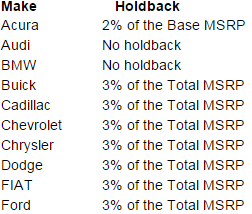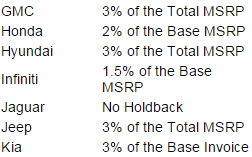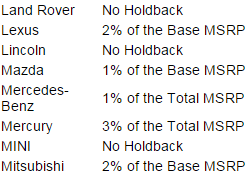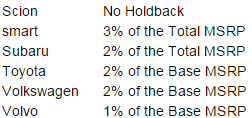How To Determine the Dealer Cost On A New Car Or Truck
When you're through reading the tutorial, you will have a firm grasp on concepts like factory invoicing, dealer hold back and how rebates affect the end result of your calculations. In learning all of these things, you will become a much savvier car shopper.
In a nutshell, this is the formula for calculating the dealer cost of new cars:
Note: You can also use our New Car Dealer Cost Calculator to simplify the calculation.





The Dealer Costs Formula:
Invoice Price - Holdback - Rebates & Incentives (If any)= Dealer Cost
Take the Invoice price and subtract the holdback. (Percentages Below). Take this amount and subtract any manufacturer rebates. To get the rebates simply fill in a price quote from one of the recommended services listed - you will receive the rebate you are entitled to in your area. (If Any)
Holdback Calculations:
- If a % of "Total" MSRP or Invoice make sure you add all the manufacturers options to the price when calculating holdback
- If a % of "Base" MSRP or Invoice, calculate hold back on the Base price before you add the options
See the steps below for more information:
Step One: Obtain The Dealer Or Factory Invoice Price
You can find dealer invoice prices from our price quides.
Base Invoice - This would be the price of the car without any options at all.
Options Invoice - The invoice that the manufacturer receives for any number of different possible options.
Destination Fees - Costs are incurred when transporting a new car from the manufacturer to the dealer; those charges will be listed as "destination fees."
Manufacturer Fees - These fees refer to the miscellaneous things the manufacturer is going to charge the dealer, and often include advertising and marketing costs along with regional ad fees.
If the dealer or factory invoice price that you're given doesn't take all of the preceding information into account, then you're not going to arrive at the true dealer cost; move on to a different site that does take these things into consideration.
Step Two: Calculate The Hold Back Or Hidden Profit
The complicated series of payments that most manufacturers make to most dealers in order to give them the incentive to stock certain vehicles is known as dealer hold back. Without it, dealers would be much more reticent to give buyers as many deals as they do; after all, the dealer has to make something on the deal, too. Negotiating around the hold back is theoretically possible but not very easy to do. Still, being aware of the hold back amount can help you be a more strategic automobile shopper.
Usually, the hold back is based on either a percentage of a vehicle's MSRP or invoice price. It is rolled into the price that the dealer pays for a new vehicle and is typically about two or three percent. However, it is paid back to the dealer at a later time. In other words, dealer cost is inflated because of hold back; knowing what the hold back amount is for any given make and model can help you arrive at actual dealer cost more efficiently.
Step Three: Calculate Dealer Cost
In order to get a basic idea about the dealer cost for any given model, simply subtract the hold back from the invoice price. Still, there's another thing that you need to keep in mind: rebates. These fall into two categories, manufacturer-to-customer programs and manufacturer-to-dealer programs, and must be subtracted from the difference between the invoice price and any hold backs in order to arrive at actual dealer cost.
Manufacturer-To-Customer Programs include things like special leases, cash rebates and low interest financing. These deals can cut into the profit that a dealer makes - and also reduce the dealer's overall cost.
Manufacturer-To-Dealer Programs revolve around marketing support money, or funds that are used to help advertise and promote dealer inventory. They are often referred to as dealer cash incentives, and may or may not be passed along to the customer. In either case, they need to be subtracted from the dealer's cost.
Upon subtracting any rebates or incentives, you should have arrived at the most accurate calculation of dealer cost possible. Armed with this information, you can get a better idea of whether you're receiving a good deal or not on that shiny new car.

